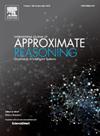Fuzzy neighborhood-based partial label feature selection via label iterative disambiguation
IF 3.2
3区 计算机科学
Q2 COMPUTER SCIENCE, ARTIFICIAL INTELLIGENCE
引用次数: 0
Abstract
Partial label learning is a specific weakly supervised learning framework in which each training sample is associated with a candidate label set in which the ground-truth label is concealed. Feature selection can remove redundant and irrelevant features to improve the generalization performance of the classification model. However, the impact of ambiguous labels is an essential challenge when adopting feature selection for partial label data. In this paper, a novel two-stage feature selection method is proposed, called fuzzy neighborhood-based partial label feature selection with label iterative disambiguation. In the first stage, the proposed method addresses the issue of noise labels by employing a neighborhood-based iterative strategy to enlarge the gap between ground-truth labels and noisy labels. Subsequently, the labeling confidence induced by label disambiguation is utilized to enhance the robustness of feature selection. In the second stage, feature significance is evaluated using three metrics based on fuzzy neighborhoods. Specifically, fuzzy dependency is obtained using fuzzy relations and labeling confidence. Fuzzy neighborhood entropy-based information gain is proposed as an uncertainty measure. Furthermore, the similarity between samples in the same fuzzy neighborhood is used to estimate neighborhood consistency. The fusion of the above metrics can select more discriminative features for partial label learning. Finally, experimental results on eight controlled UCI datasets and five real-world datasets demonstrate that the proposed method achieves superior performance than other compared methods.
基于标签迭代消歧的模糊邻域部分标签特征选择
部分标签学习是一种特定的弱监督学习框架,其中每个训练样本都与一个隐藏真值标签的候选标签集相关联。特征选择可以去除冗余和不相关的特征,提高分类模型的泛化性能。然而,当对部分标签数据采用特征选择时,歧义标签的影响是一个重要的挑战。本文提出了一种新的两阶段特征选择方法,即基于模糊邻域的标签迭代消歧部分标签特征选择方法。在第一阶段,提出的方法通过采用基于邻域的迭代策略来解决噪声标签的问题,以扩大地面真值标签与噪声标签之间的差距。随后,利用标签消歧诱导的标签置信度来增强特征选择的鲁棒性。在第二阶段,使用基于模糊邻域的三个度量来评估特征的重要性。具体来说,利用模糊关系和标记置信度得到模糊依赖关系。提出了基于模糊邻域熵的信息增益作为不确定性测度。进一步,利用同一模糊邻域内样本间的相似度来估计邻域一致性。以上指标的融合可以选择更多的判别特征进行部分标签学习。最后,在8个受控UCI数据集和5个真实数据集上的实验结果表明,该方法的性能优于其他比较方法。
本文章由计算机程序翻译,如有差异,请以英文原文为准。
求助全文
约1分钟内获得全文
求助全文
来源期刊

International Journal of Approximate Reasoning
工程技术-计算机:人工智能
CiteScore
6.90
自引率
12.80%
发文量
170
审稿时长
67 days
期刊介绍:
The International Journal of Approximate Reasoning is intended to serve as a forum for the treatment of imprecision and uncertainty in Artificial and Computational Intelligence, covering both the foundations of uncertainty theories, and the design of intelligent systems for scientific and engineering applications. It publishes high-quality research papers describing theoretical developments or innovative applications, as well as review articles on topics of general interest.
Relevant topics include, but are not limited to, probabilistic reasoning and Bayesian networks, imprecise probabilities, random sets, belief functions (Dempster-Shafer theory), possibility theory, fuzzy sets, rough sets, decision theory, non-additive measures and integrals, qualitative reasoning about uncertainty, comparative probability orderings, game-theoretic probability, default reasoning, nonstandard logics, argumentation systems, inconsistency tolerant reasoning, elicitation techniques, philosophical foundations and psychological models of uncertain reasoning.
Domains of application for uncertain reasoning systems include risk analysis and assessment, information retrieval and database design, information fusion, machine learning, data and web mining, computer vision, image and signal processing, intelligent data analysis, statistics, multi-agent systems, etc.
 求助内容:
求助内容: 应助结果提醒方式:
应助结果提醒方式:


